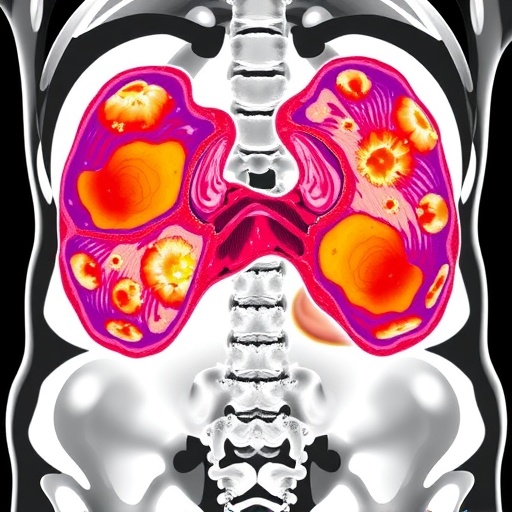In a groundbreaking study poised to reshape the landscape of prostate cancer diagnostics, researchers have evaluated the predictive value of specific histological patterns—namely intraductal carcinoma of the prostate (IDC-P) and invasive cribriform carcinoma (ICC)—on the presence of genetic mutations in patients who have not received systemic therapies. The comprehensive analysis, published in the prestigious journal BMC Cancer, challenges preconceived notions regarding the linkage between tumor morphology and underlying genomic alterations, advocating for a refined approach in genetic testing strategies.
Prostate cancer remains one of the most prevalent malignancies affecting men worldwide, with its clinical behavior and treatment response often influenced by distinct molecular and histopathological features. Among these, IDC-P and ICC have garnered attention due to their aggressive phenotypes and association with adverse outcomes. Traditionally, their presence has been considered a beacon signaling potential genetic aberrations, particularly mutations in critical DNA repair pathways such as homologous recombination repair (HRR) and mismatch repair (MMR), which are therapeutic targets in personalized medicine.
The investigative team conducted a rigorous retrospective review encompassing 347 prostate cancer patients who had never been exposed to systemic treatment modalities. These individuals underwent extensive genomic profiling from January 2018 through May 2024 at a single tertiary care institution, ensuring uniformity in diagnostic and analytic methods. The correlation between histological subtypes and gene mutation landscape was meticulously examined, with additional consideration given to clinical parameters including age and tumor grading.
Intriguingly, the study unveiled that a staggering 73.2% of the cohort exhibited IDC-P or ICC histopathological traits. However, the prevalence of HRR gene mutations among these patients—24.8%—was not significantly different from those lacking such features, which exhibited a mutation rate of 22.6%. Similarly, MMR gene mutations were rare across both groups, detected in only 2.8% of patients with aggressive patterns versus 1.1% without. These findings underscore a disconnect between tumor architecture and the frequency of actionable genetic mutations.
Beyond mere detection frequencies, the analysis extended into exploring classical biomarkers like prostate-specific antigen (PSA) levels, microsatellite instability (MSI), and overall tumor mutational burden (TMB). No discernible variations emerged between patients harboring IDC-P/ICC and those without. This suggests that histologic aggressiveness does not inherently correspond to elevated molecular instability or mutational load, further complicating the use of morphology as a standalone predictor.
Employing logistic regression modeling, investigators identified two potent predictors of HRR gene mutations: lower Grade Groups and younger age at initial diagnosis. Grade Group, denoting Gleason score categories, retains its status as a robust indicator of tumor differentiation and aggressiveness. The inverse relationship with age challenges standard perceptions, hinting at distinct oncogenic pathways in early-onset prostate cancers that may predispose to repair pathway defects.
Critically, the presence of intraductal or cribriform carcinoma failed to achieve statistical significance in forecasting HRR gene mutation status, with a P-value of 0.827. This result stands in contrast to prior assumptions, illuminating that morphological evaluation alone cannot reliably guide genetic testing decisions. Therefore, clinical practice should pivot toward integrating demographic and pathological data rather than over-relying on histology.
This revelation carries profound ramifications for personalized oncology, where the tailoring of therapy increasingly depends on the identification of molecular vulnerabilities. PARP inhibitors, for instance, have transformed treatment landscapes for cancers harboring HRR defects, offering substantial clinical benefits. Accurate selection criteria for genetic screening are thus paramount to optimize patient outcomes and resource allocation.
Moreover, the findings challenge pathologists and clinicians to revisit prostate cancer classification schemas. While IDC-P and ICC confer prognostic significance, their utility diminishes as predictors for specific genetic alterations that inform systemic therapy choices. The decoupling of morphological aggression from genetic drivers necessitates the development of multidimensional diagnostic algorithms incorporating clinical factors, histology, and genomic insights.
The study’s robust dataset and standardized approach lend credence to these conclusions, yet it also calls for further multicenter validation. Diverse populations and prospective methodologies could bolster understanding and refine predictive models. Meanwhile, clinicians are advised to interpret histologic findings within a broader context, balancing genetic testing triggers with patient age, tumor grade, and comprehensive clinical assessment.
This paradigm shift exemplifies the evolving interface between histopathology and molecular oncology, affirming that single-dimensional views rarely suffice in the era of precision medicine. The intricate biology of prostate cancer demands nuanced perspectives that transcend traditional morphological classification and embrace integrated diagnostic frameworks.
As research continues to unravel the complexities of tumor heterogeneity and genetic underpinnings, this investigation marks a pivotal step toward enhancing the accuracy of mutation prediction and, by extension, the personalization of prostate cancer care. Ultimately, these insights may catalyze more effective screening protocols, guiding therapeutic interventions that improve survival and quality of life for affected patients.
In sum, this landmark study elucidates the limitations of relying on intraductal and cribriform growth patterns as surrogates for genetic mutation presence in systemic treatment-naïve prostate cancer. Instead, it advocates for a balanced approach anchored in clinical and pathological variables, reframing diagnostic strategies as the oncology community progresses toward bespoke treatment paradigms.
Subject of Research: Evaluation of the predictive value of intraductal carcinoma of the prostate and invasive cribriform carcinoma in relation to genetic mutations in treatment-naïve prostate cancer patients.
Article Title: Evaluation of intraductal carcinoma and invasive cribriform carcinoma as predictors of genetic mutations in systemic treatment-naïve prostate cancer patients.
Article References: Lee, S., Park, I., Ahn, B. et al. Evaluation of intraductal carcinoma and invasive cribriform carcinoma as predictors of genetic mutations in systemic treatment-naïve prostate cancer patients. BMC Cancer 25, 1736 (2025). https://doi.org/10.1186/s12885-025-15001-2
Image Credits: Scienmag.com
DOI: 10 November 2025




